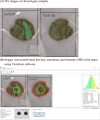Physical frailty and oral health as risk factors for low bone density in community-dwelling residents
- PMID: 39103423
- PMCID: PMC11300787
- DOI: 10.1038/s41598-024-68958-8
Physical frailty and oral health as risk factors for low bone density in community-dwelling residents
Abstract
This study aimed to explore the association between bone mineral density and physical frailty including nutrition, muscle mass, and oral function. We included participants aged 35-80 years and examined their bone mineral density, serum albumin level, body composition, and variance of hue (VOH) of two-colored gum. We also used the geriatric oral health assessment index (GOHAI). These data were used to calculate the geriatric nutritional risk index (GNRI) and skeletal muscle index (SMI). Multinomial logistic regression was performed to assess the relationship between GNRI, SMI, VOH, GOHAI, and bone mineral density after adjusting for comorbidities, including hypertension, diabetes mellitus, and previous bone fracture. We included 228 participants and classified their bone mineral density as normal, osteopenic, or osteoporotic. Older age (odds ratio (OR) 1.15, 95% confidence interval (CI) [1.08, 1.23]), low GNRI (OR 0.90, 95% CI [0.83, 0.98]), low SMI (OR 0.43, 95% CI [0.27, 0.68]), and high VOH (OR 1.08, 95% CI [1.01, 1.17]) were significantly associated with osteoporosis. Older age (OR 1.08, 95% CI [1.04, 1.11]) and low GNRI (OR 0.93, 95% CI [0.87, 0.99]) were significantly associated with osteopenia. GNRI, SMI, and VOH were significantly associated with osteoporosis among male participants. Although the multinomial logistic regression analysis indicated that GNRI, SMI, VOH, and GOHAI were not significantly associated with osteoporosis or osteopenia among female participants, the demographic distribution showed that older age, low GNRI, and low SMI were significantly associated with bone mineral density decline. Physical frailty, including nutritional decline, muscle mass loss, and poor oral status, is associated with low bone density. This easy-to-use tool can be used to detect osteoporosis early and to prevent osteoporosis and osteoporosis-related fractures.
Keywords: Bone mineral density; Frailty; GNRI; Osteoporosis; SMI; Two-colored gum.
© 2024. The Author(s).
Conflict of interest statement
The authors declare no competing interests.
Figures
Similar articles
-
Low geriatric nutritional risk index is associated with osteosarcopenia in older patients with type 2 diabetes mellitus.BMC Musculoskelet Disord. 2024 Nov 26;25(1):959. doi: 10.1186/s12891-024-08091-9. BMC Musculoskelet Disord. 2024. PMID: 39587533 Free PMC article.
-
Associations among Geriatric Nutrition Risk Index, bone mineral density, body composition and handgrip strength in patients receiving hemodialysis.Nutrition. 2019 Sep;65:6-12. doi: 10.1016/j.nut.2019.02.013. Epub 2019 Feb 26. Nutrition. 2019. PMID: 31029923
-
Association between the Geriatric Nutritional Risk Index, bone mineral density and osteoporosis in type 2 diabetes patients.J Diabetes Investig. 2020 Jul;11(4):956-963. doi: 10.1111/jdi.13196. Epub 2020 Jan 20. J Diabetes Investig. 2020. PMID: 31828962 Free PMC article.
-
The Association Between Nutritional Risk and Bone Stiffness in Elderly Men and Women in a Population-Based Study in Northeast Germany.Nutrients. 2024 Dec 12;16(24):4288. doi: 10.3390/nu16244288. Nutrients. 2024. PMID: 39770909 Free PMC article.
-
Oral health indicators and bone mineral density disorders in older age: A systematic review.Ageing Res Rev. 2024 Sep;100:102412. doi: 10.1016/j.arr.2024.102412. Epub 2024 Jul 9. Ageing Res Rev. 2024. PMID: 38992442
Cited by
-
[Analysis of demographic and clinical characteristics of 744 inpatients with osteoporotic vertebral compression fractures].Zhongguo Xiu Fu Chong Jian Wai Ke Za Zhi. 2025 Mar 15;39(3):354-361. doi: 10.7507/1002-1892.202411068. Zhongguo Xiu Fu Chong Jian Wai Ke Za Zhi. 2025. PMID: 40101912 Free PMC article. Chinese.
References
-
- Pisulkar, S., Pisulkar, G., Pakhan, A. D., Godbole, S. & Dahane, T. Mandibular bone mineral density to predict skeletal osteoporosis: A literature review. Int. J. Recent Surg. Med. Sci.02, 096–101. 10.5005/jp-journals-10053-0021 (2016).10.5005/jp-journals-10053-0021 - DOI
MeSH terms
Grants and funding
LinkOut - more resources
Full Text Sources
Medical


